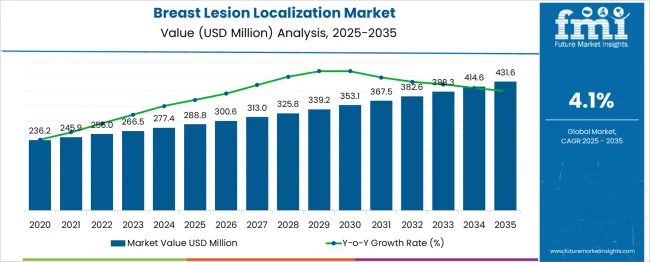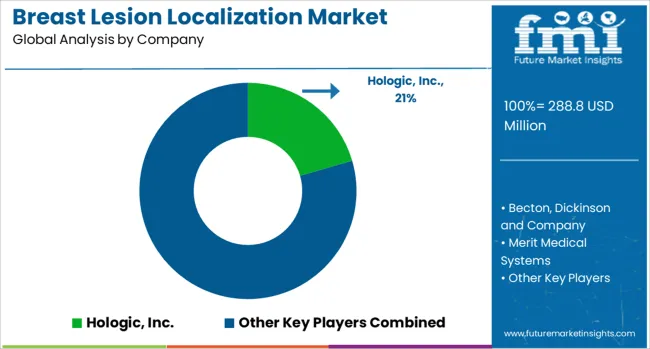The Breast Lesion Localization Market is estimated to be valued at USD 288.8 million in 2025 and is projected to reach USD 431.6 million by 2035, registering a compound annual growth rate (CAGR) of 4.1% over the forecast period.

| Metric | Value |
|---|---|
| Breast Lesion Localization Market Estimated Value in (2025 E) | USD 288.8 million |
| Breast Lesion Localization Market Forecast Value in (2035 F) | USD 431.6 million |
| Forecast CAGR (2025 to 2035) | 4.1% |
Rising chronic diseases like breast cancer and multiple diagnosis methods including early detection and screening coupled with it being the most prevalent cancer are helping the breast lesion localization market gain traction
The government initiatives are working in order to spread awareness around breast cancer, diagnosis, symptoms, surgeries, and stages that help people in fighting against breast cancer.
Government programs also promote multiple kinds of diagnosis, treatment, and screening processes that help doctors and patients understand the real-time situation, pushing the demand for breast lesion localization. Another factor that creates multiple opportunities for the market is the high capital investments of emerging economies like India and China in their healthcare sector.
These countries are currently upgrading or building their healthcare structure, spending huge amounts on the development of the infrastructure. Countries also run programs to welcome the companies that provide a direct supply chain to healthcare and diagnostics services.
The shortage of oncologists is limiting the sales of breast lesion localization systems that perform by skilled professionals. The localization of tumors, lymphedema, seroma and risk of healthy tissue excision are some of the processes that breast lesion localization has.
Other reasons that restrict the market’s growth are the FDA approvals and the uncertainty attached to it. Players that operate the breast lesion localization need to obtain nuclear regulatory clearance to get listed among the registered operators.
The breast lesion localization market is categorized by type and usage. These categories are further divided into small segments that expand their channels in multiple market spaces. These segments perform differently in multiple markets as they have a stronghold in multiple regions.
The type category is segmented into wire localization, radioisotope localization, magnetic localization, and electromagnetic localization, while the usage category is divided into breast biopsy and breast conservation (Lumpectomy).
By usage, the breast biopsy segment is the largest segment and will hold the biggest portion of the market in the forecast period. The analysis shows that the breast biopsy segment is set to thrive at a CAGR of 3.5% in the forecast period, while previously, the segment was thriving at a slightly higher CAGR of 4.0%.
Breast lesion localization market analysis explains that the factors behind the growth of this segment are its easy removal and short time span, and lower post-surgery impacts than the lumpectomy. Also, the breast biopsy can be used to remove an abnormality within the breast, while lumpectomy (Partial mastectomy) can only be used to remove breast cancer. These factors flourish the demand for breast lesion localization market.
The breast lesion localization market is divided into regions; North America, Latin America, Asia Pacific, Middle East and Africa (MEA), and Europe. The biggest market is the United States, which is flourishing at a CAGR of 3.9% between 2025 to 2035.
The region is likely to hold a market revenue of USD 431.6 Million by the end of 2035. Increasing breast cancer cases coupled with advanced diagnosis options while upgrading the healthcare system and their integration with the latest technology like AI and IOT are fueling the growth in this region.
The UK is the highest growing market globally and will hold USD 18.2 Million by the end of 2035 as it thrives on a promising CAGR of 4.4% between 2025 to 2035. Other regions like Asia pacific also flourished, with developing countries like China booming at a CAGR of 3.6% and Japan growing at a CAGR of 3.8%, while their projected values are USD 28 Million and USD 25.2 Million, respectively.
| Regions | CAGR (2025 to 2035) |
|---|---|
| United States | 3.9% |
| United Kingdom | 4,4% |
| China | 3.6% |
| Japan | 3.8% |
| South Korea | 3.0% |

The competitive landscape of breast lesion localization is dynamic in nature and allows new competitors to thrive in the market and increase competitiveness. The companies in the market are a part of mergers and collaborations that result in increased distribution channels and market spaces. These companies focus on updating the price ranges, while making the platforms more patient friendly.
Recent Developments in the Breast Lesion Localization Market:
The global breast lesion localization market is estimated to be valued at USD 288.8 million in 2025.
The market size for the breast lesion localization market is projected to reach USD 431.6 million by 2035.
The breast lesion localization market is expected to grow at a 4.1% CAGR between 2025 and 2035.
The key product types in breast lesion localization market are wire localization, radioisotope localization, magnetic localization, electromagnetic localization and other localization methods.
In terms of usage, breast biopsy segment to command 62.4% share in the breast lesion localization market in 2025.






Full Research Suite comprises of:
Market outlook & trends analysis
Interviews & case studies
Strategic recommendations
Vendor profiles & capabilities analysis
5-year forecasts
8 regions and 60+ country-level data splits
Market segment data splits
12 months of continuous data updates
DELIVERED AS:
PDF EXCEL ONLINE
Breast Lesion Localization Device Market Analysis - Size, Share, and Forecast Outlook 2025 to 2035
Breast Reconstruction Meshes Market Size and Share Forecast Outlook 2025 to 2035
Breast MRI Screening Market Size and Share Forecast Outlook 2025 to 2035
Breast Density Assessment Software Market Size and Share Forecast Outlook 2025 to 2035
Breast Cancer Grading Tools Market Size and Share Forecast Outlook 2025 to 2035
Breast Cancer Screening Tests Market Size and Share Forecast Outlook 2025 to 2035
Breast Cancer Diagnostics Market Size and Share Forecast Outlook 2025 to 2035
Breast Biopsy Market Size and Share Forecast Outlook 2025 to 2035
Breastfeeding Accessories Market Size and Share Forecast Outlook 2025 to 2035
Breast Biopsy Devices Market Analysis - Innovations & Forecast 2025 to 2035
Breast Reconstruction Surgery Market Analysis - Size, Share, and Forecast 2025 to 2035
Breast Pump Market – Trends & Forecast 2025 to 2035
Breast Fillers Market Analysis - Trends & Forecast 2025 to 2035
The Breast Cancer Drug Market is segmented by Drug Class, and Distribution Channel from 2025 to 2035
Industry Share & Competitive Positioning in Breast Implants Market
Industry Share & Competitive Positioning in Breast Reconstruction Surgery Market
Breast Imaging Market Analysis - Size, Share & Growth Forecast 2024 to 2034
Breast Localization System Market
Smart Breast Imaging Market Analysis - Size, Share, and Forecast Outlook 2025 to 2035
Breast & Prostate Cancer Diagnostics Market in Europe – Trends & Forecast 2025 to 2035

Thank you!
You will receive an email from our Business Development Manager. Please be sure to check your SPAM/JUNK folder too.
Chat With
MaRIA